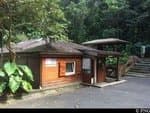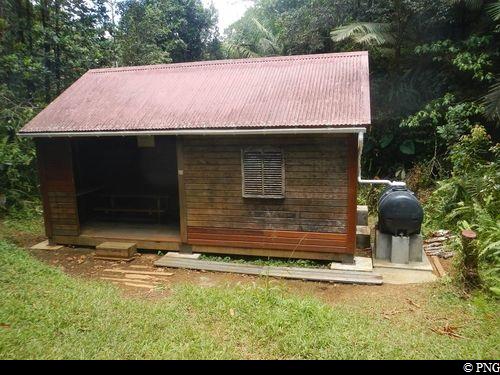
Morne Léger
12 points of interest
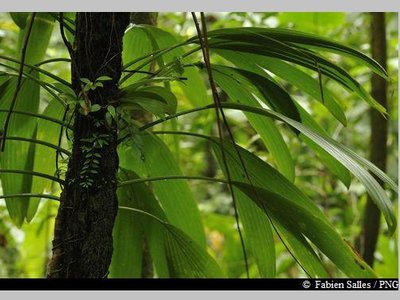
"Ailes à mouches" - Fabien Salles / PNG  Flora
Flora"Ailes à mouches"
A member of the Cyclantaceae family, the French common name of Asplundia rigida translates literally as "fly wings" on account of its similarity with the insect. A typical plant of hygrophilous (moisture-loving) forest undergrowth, there are three species of Asplundia: two terrestrial and one epiphytic and lianescent (vines climbing from aerial routes).
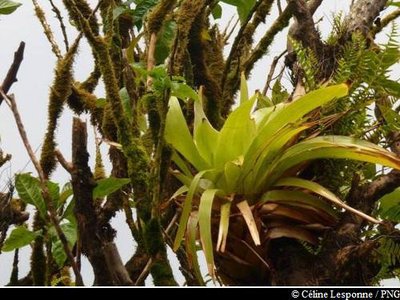
"Ananas bois" - Céline Lesponne / PNG  Flora
FloraGlomeropitcairnia penduliflora
Commonly known in Creole as "Zanana mawon", Glomeropitcairnia penduliflora is a member of the Bromeliaceae family. It is a tropical grass, epiphyte on tree branches, or terrestrial. It has straight, tough and thick leaves which, arranged in the format of rosettes, take in substantial levels of water and are even home to some frogs. It features a floral scape in the middle.
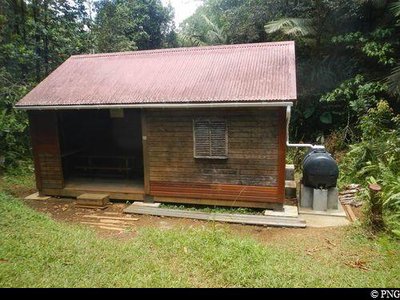
Refuge du Morne Léger - PNG  Mountain shelter
Mountain shelterMorne Léger bivouac
The Morne Léger bivouac (shelter) has room for around 10 people to sleep in the heart of the rainforest.
It is strongly recommended that you bring your own floor mat or hammock (plus fasteners), because there are only wooden bunks available on site.
N.B. The shelters have no running water or electricity available. They are not supervised and do not include a cleaning service. Please leave them clean and tidy !
Les deux Mamelles - Emilie Savy / PNG  Viewpoint
ViewpointLes Mamelles
View of Les Mamelles : La Mamelle de Pigeon to the west and La Mamelle de Petit-Bourg to the east.

Palétuvier jaune - Emilie Savy / PNG  Flora
FloraMapou baril
Sterculia caribea, known in Créole as Mapou baril, is endemic to the Lesser Antilles. The leaves of this plant can differ depending on its age. Its flowers appear in the form of a bunch of small yellow and pink bells. It produces quite distinctive fruits that cluster together in groups of four or five in woody follicles: they are lined on the inside with dark red urticating bristles.
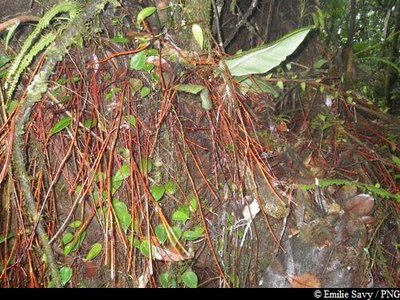
"Bwa rouj karapat" - Emilie Savy / PNG  Flora
FloraAmanoa caribeae
Amanoa caribeae belongs to the Euphorbiaceae family. This species is endemic to the Lesser Antilles.
It is a large tree with a trunk that rests straight on its buttresses, depending on the terrain. The most distinctive features of this species are its reddish bark and roots at the foot of the trunk. Its leaves vary in shape: sometimes they are whole, sometimes pointed. Its flowers form small clusters. The hard wood of this tree was used as timber or in carpentry.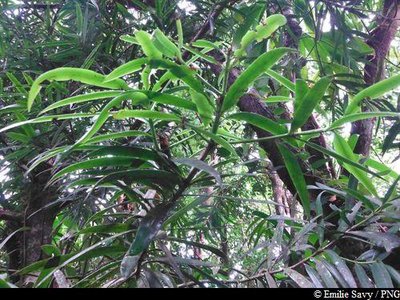
Laurier montagne - Emilie Savy / PNG  Flora
FloraThe Yucca Plum Pine
A member of the Podocarpaceae family, Podocarpus coriaceus is also known as the Yucca Plum Pine. Similar to conifers, the Yucca Plum Pine is an average-sized tree that can grow between 10-16 metres tall. It has leathery leaves that resemble an oleander's. They are dark green on top, with a span of 6-15cm and virtually no petiole. Its flowers are discreet, but its brownish seeds in its red buds are certainly eye-catching. It has a thin layer of bark. This species is found throughout the West Indies and flowers mainly in December and January.
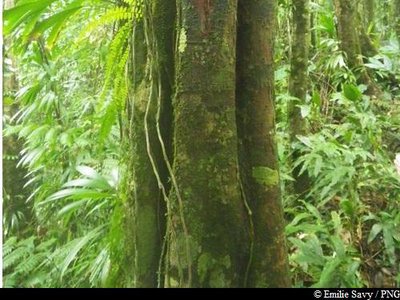
Bois cotelette noir - Emilie Savy / PNG  Flora
FloraTapura latifolia
Tapura lotifolia is a member of the Melastomaceae family. With a fluted trunk, this tree rarely grows taller than 20 metres. Its leaves feature five main lengthways veins that run perpendicular to its many secondary veins.
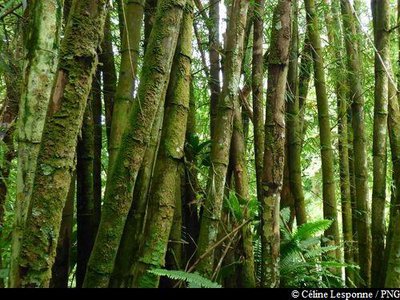
Bambou - Céline Lesponne / PNG  Flora
FloraBamboo
A member of the Poaceae family, bamboo is more closely related to grasses than to trees. Made up of a woody, hollow stalk, its stem grows extremely quickly. It is both a highly resistant and invasive species in Guadeloupe and concerted efforts are being made to put it to best use in crafts and construction.
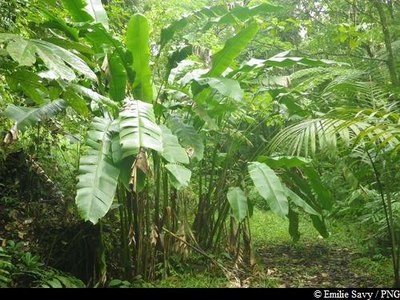
Balisiers - Emilie Savy / PNG  Flora
FloraBalisiers
A member of the Musaceae family, Heliconia caribaea is a large grass that is typical of the Lesser Antilles tropical rainforest. A member of the same family as the banana trees, the plant can grow up to 5 m high. It features an inflorescence that resembles a red ear or red ear with yellow trim, or sometimes completely yellow. Its flowers are visible all year round, most notably between April and June.

Bois cotellette blanc - Emilie Savy / PNG  Flora
FloraMiconia mirabilis
Miconia mirablis is a hardwood tree with white bark and fluted trunk. As is so distinctive of pioneer plants, it loves light. It is often found on paths alongside tree ferns or trumpet trees.

feuilles de Bois Canon - Fabien Salles / PNG  Flora
FloraPumpwood
Most common in light, windfall area or at roadsides, the Pumpwood (Cecropia shreberiana) consists of a straight, hollow trunk with white bark and few branches. Here, you cannot miss it when you leave the forest and when you arrive at the intersection with the road. Its webbed leaves are white underneath and highly distinctive. They are green on top and form in clusters at the ends of branches. The Pumpwood flowers all year round. In traditional medicine, its leaves are made into a decoction which is used as a diuretic. It also acts as a tonic, anti-asthmatic and cardiac stimulant. Its latex can be used to treat bruises and surface wounds. The sap from its folded leaves is used to treat bronchitis.
Description
Hiking trail colour: yellow
From the parking area of Col des Mamelles, head down eastwards along the road (towards Maison de la Forêt) for a short while to reach the start of the trail, marked by the sign: "Abri du Morne Léger, Route forestière de Grosse Montagne, Trace des Alizés". Go past the Morne léger shelter. Provided you have brought a hammock or small camping mat, you can sleep at the shelter. Make sure you bring a light source, water and warm clothes. Keep going on the path and then turn left before the Casimir ridge. Keep going straight on towards "Morne Léger, Route forestière" at the intersection with the ridge. The path is narrow and branches off to the right, so follow the yellow signs carefully. You will then get to Morne Léger, which stands at 631 metres above sea level. Keep going on the track, being careful not to lose your way. At the next intersection, turn right onto the "Route des Mamelles" forest road. Continue on the same track, the Quiock river crossing shows the arrival nearby. On the left, cross the path that leads to the Quiock circular trail and stay right to return to Route RD23.
The climb on foot on the road up to Col des Mamelles is long and dangerous.
N.B. As this is a circular trail, make sure to leave your vehicle at the start point.
- Departure : Col des Mamelles, opposite the start point of la Mamelle Pigeon
- Arrival : Intersection RD23 / Quiock river trail
- Towns crossed : Petit-Bourg, Pointe-Noire, and Lamentin
Altimetric profile
Recommandations
Pay attention to cars on Route RD23, as it is a major road.
There are no litter bins on the route, so please be considerate and take your rubbish with you.
Extra care should be taken in this natural environment, as Guadeloupe is prone to natural risks. For the benefit of all hikers, it is very important that you behave responsibly.
Please note: the parking areas are not supervised.
Information desks
Maison de la Forêt
RD 23 - Route de la Traversée, 97170 Petit-Bourg
Opening hours :
- In low season (May 1 to June 30 and September 1 to October 31) : every day (except weekends) from 9 am to 4.30 pm.
- In high season (November 1 to April 30 and from July 1 to August 31) : every day from 9 am to 4.30 pm ; sunday from 9 am to 12.30 pm.
Services: reception, permanent exhibition, free parking, picnic area nearby. Building accessible to people with reduced mobility.
Please note : parkings are not supervised.
Localisation GPS : Lat: 16,17600 N - Lng: 61,69280 W.
Access and parking
GPS coordinates of the start point : Lat : 16,18175 N - Long : 61,73662 W.
On Route de la Traversée (RD 23), the parking area for the start of the trail is located near the Col des Mamelles.
-> If coming from Côte-sous-le-Vent (Bouillante / Pointe-Noire): stop at the car park situated at the Col, on the left.
-> From the other side (Prise d'Eau, Petit Bourg): you will need to drive for around 5 km after Maison de la Forêt to find parking on the right.
Parking :
Source
Report a problem or an error
If you have found an error on this page or if you have noticed any problems during your hike, please report them to us here:

